Last week, LEGO announced the results of the LEGO Ideas second 2016 review period, which included twelve qualifying projects that achieved 10,000 public votes. Based on the announcement, the next LEGO Ideas set is going to be Women of NASA by Maia Weinstock (a.k.a 20tauri), and LEGO is still considering the Voltron – Defender of the Universe by len_d69. Further details below on both projects, and more. 🙂
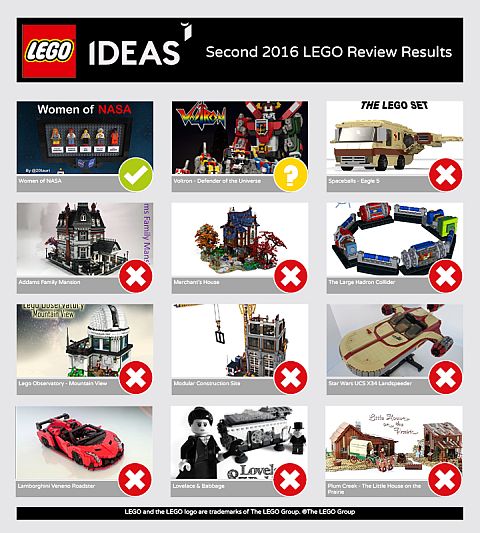
LEGO released a fairly long video-announcement with LEGO Ideas Marketing Manager, Lise Dydensborg, discussing the twelve projects in the review period. She also mentions that the LEGO Ideas Women of NASA set should be available sometime at the end of this year/beginning of next year.
As a science editor and writer for MIT, with a strong personal interest for space exploration as well as the history of women in science and engineering, Maia’s Women of NASA project was a way for her to celebrate accomplished women in the STEM professions. In particular those who’ve made a big impact through their work at NASA. Her project obviously resonated with others as it reached the required 10,000 votes in just 15 days!
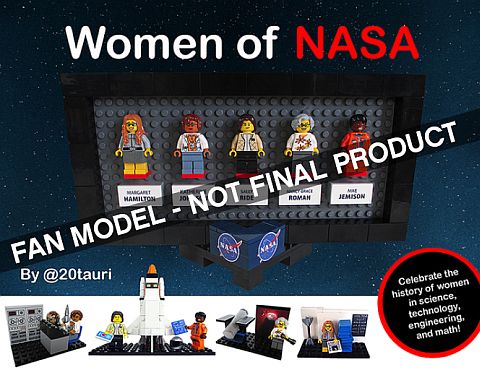 There is a very interesting interview with Maia on the LEGO Ideas blog where she shares how the idea for the project came about: “I played with LEGO as a child in the 1980s, but my connection to it faded as I grew older. I became interested again in late 2009, when I thought to make a custom minifigure of a friend who is a scientist. I subsequently decided to design more of these for other scientists, and to photograph them and put them online. I also began trying to meet up with scientists and engineers after I make a minifigure of them, and it’s always amusing to see their reaction. I’ve said before, and it’s really true, that I feel like Santa Claus when this happens, because even the most well-regarded, world-renowned scientists and engineers light up like a kid on Christmas when they see their minifig in person.”… “The Women of NASA set combines several of my personal passions: space exploration, the history of women in science and engineering, and, of course, LEGO. In 2014, I curated an art exhibit featuring portraits of women in science, and for my part of the exhibit I mounted and framed individual minifigures of real-life scientists that I’d previously designed. They were a huge hit. So the frame part of the model stems from that idea, as I thought people might like to build their own display featuring minifigs of accomplished women in the STEM professions. The vignettes came second, and for those I wanted to contextualize each person in terms of her contribution to NASA history.”
There is a very interesting interview with Maia on the LEGO Ideas blog where she shares how the idea for the project came about: “I played with LEGO as a child in the 1980s, but my connection to it faded as I grew older. I became interested again in late 2009, when I thought to make a custom minifigure of a friend who is a scientist. I subsequently decided to design more of these for other scientists, and to photograph them and put them online. I also began trying to meet up with scientists and engineers after I make a minifigure of them, and it’s always amusing to see their reaction. I’ve said before, and it’s really true, that I feel like Santa Claus when this happens, because even the most well-regarded, world-renowned scientists and engineers light up like a kid on Christmas when they see their minifig in person.”… “The Women of NASA set combines several of my personal passions: space exploration, the history of women in science and engineering, and, of course, LEGO. In 2014, I curated an art exhibit featuring portraits of women in science, and for my part of the exhibit I mounted and framed individual minifigures of real-life scientists that I’d previously designed. They were a huge hit. So the frame part of the model stems from that idea, as I thought people might like to build their own display featuring minifigs of accomplished women in the STEM professions. The vignettes came second, and for those I wanted to contextualize each person in terms of her contribution to NASA history.”
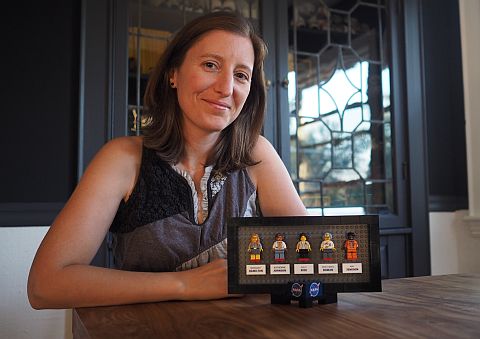
NASA projects are very much in the news these days, and it is nice to see that people are yet again showing more interest in space exploration. The LEGO Ideas Women of NASA set also comes on the heels of the recently released and very well received film titled Hidden Figures. The movie follows the lives of three African American female mathematicians who worked at NASA during the Space Race of the 1960s. Katherine Johnson was a mathematician who calculated flight trajectories for Project Mercury and other missions, Dorothy Vaughan was the first black supervisor at NASA and one of the few female supervisors, and Mary Jackson was NASA’s first black female engineer.
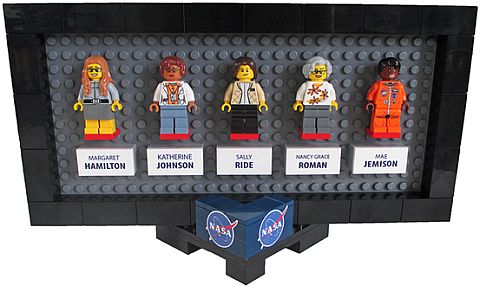
Katherine Johnson is included as one of the scientists in LEGO Ideas Women of NASA set, and the other four minifigs are based on computer scientist Margaret Hamilton who developed the on-board flight software for the Apollo mission to the moon in the 1960s, astronaut Sally Ride who became the first American woman in space in 1983, astronomer Nancy Grace Roman who is known as the “Mother of Hubble” for her role in planning the Hubble Space Telescope, and astronaut Mae Jemison who was the first African-American woman in space in 1992.
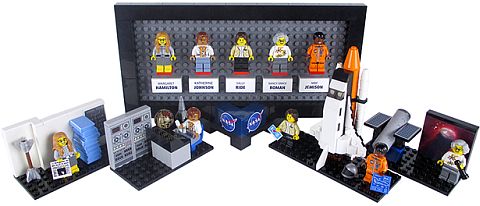
In addition to a desktop frame that displays these five minifigures and their names, the set includes some small vignettes depicting a famous photo of the reams of code that landed astronauts on the moon in 1969, the instruments used to calculate and verify trajectories for the Mercury and Apollo missions, a microscale Hubble Space Telescope and display, and a mini space shuttle complete with external tank and solid rocket boosters.
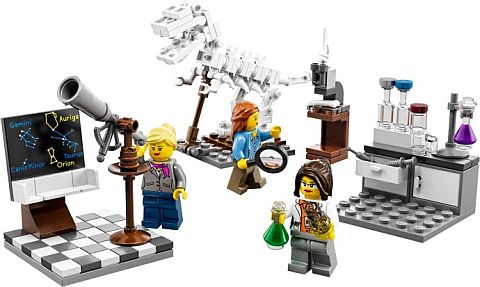
And Women of NASA is a worthy successor of the #21110 LEGO Ideas Research Institute from 2014, which was also well-received and sold out very quickly. In fact, the two sets are similar in more than one way; both highlighted women in scientific fields, and both come with several minifigures and small vignettes. While we are waiting for LEGO Ideas Women of NASA to be released, you can also check out the currently available LEGO Ideas sets originally designed by LEGO fans at the LEGO Ideas section of the Online LEGO Shop.

Although the other project in the review were not approved, LEGO is still considering the Voltron – Defender of the Universe by len_d69. My guess is that LEGO likes the model and would like to produce it, but they have to work out licensing agreements. Robots are always popular, so the set should do well. We should hear the final decision sometime this summer.

In the meantime, the next batch of LEGO Ideas projects are already in review. These are the submissions that reached 10,000 supporters between September 2016 and January 2017 as possible future LEGO sets. The LEGO Ideas team will share the results of their decision this summer as well.
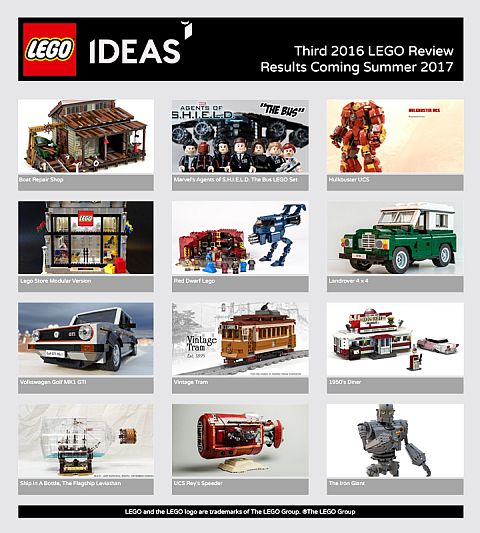
What do you think? How do you like the results of this latest LEGO Ideas announcement? Are you excited about the new set, or would you have preferred one of the other projects? Which models would you like to see becoming an official LEGO set from the next review period? Feel free to share and discuss in the comment section below! 😉
And you might also like to check out the following related posts:












I desperately hope they make more of these than they did the Research Institute. That set needed more copies printed IMO, but as usual LEGO doesn’t respect female representation in System sets. Sad that female characters are mostly relegated to the Minidoll ghetto
Yeah, I hope they make enough too. LEGO actually has been significantly better in the last five years with including female minifigs in practically every set. There are so many more female torsos and facial prints, I have a hard time keeping up! (I collect them for my city.) And the number of female hairstyles exploded hugely! I really should write an article about this, because there are people who are not aware of all the new yellow and flesh-skinned female minifigs available, and all the beautiful hair pieces. 🙂
I am not saying it’s not better, but it’s nowhere near equal yet.
It’s equal if you count Friends, Elves and Disney characters as equal members of the minifig population. 😉
That’s my exact problem though, that LEGO themselves seems to think it’s “good enough” to have girl-oriented lines where the female figures are kept and boy-oriented lines where they are far more rare. Little boys need to have girl minifgures to play with also, and similarly they could probably stand to make more male minidolls to get both lines closer to actual gender parity.
It’s not so much about LEGO lazily thinking or carelessly speculating if something is good enough for girls and boys. “Good enough” was never the motto of LEGO. They did not make the decision to introduce mini-dolls haphazardly. In fact, it was a huge risk for them, a brand new direction. Something most companies would shy away from and just stick with what they know.
LEGO spent a billion (yeah, that’s with a “B”) dollars on extensive research working with real children to see what they wanted. Little girls consistently preferred more human looking characters that looked like them, and not minifigs. This has been tested over and over again. They also wanted toys that are more based on socializing and story-telling, rather than action-features. And girls love decorating! The research obviously paid off, as the mini-doll based lines are hugely successful, and LEGO was finally able to reach part of the population that always eluded them.
While giving both boys and girls what they naturally like to play with, LEGO has been also adding elements to their sets to blur the lines between boy and girl toys, and encourage children of both genders to try different things. The LEGO Friends line gives girls what they naturally gravitate to, but there are also building and action features involved that are normally more interesting to boys. And sets that are more attractive to boys include some features that usually girls like. And of course all LEGO sets can be mixed and matched for unlimited possibilities. It is also worth noting that the upcoming LEGO BOOST robotics set is going to be much more gender-neutral than those ugly Mindstorms components (I’m saying this as a girl, who was always intimidated by Mindstorms because of its aggressive look).
LEGO has been going far beyond the call of duty what is normally expected from a toy company. They do care about the wellbeing of children, and they do want to be a valuable part of the education of future generations, even if they are not required to do that. And they put their money where their mouth is. I respect the fact that they were willing to risk their reputation to go with what their research found, even if it isn’t politically correct at this point in time. They were willing to listed to children, and give them what they naturally wanted, rather than what adults think is politically correct for children to have.
Having equal opportunities is important. Which means boys should be able to enter more traditionally feminine fields, and girls should be able to compete with the boys, if they want to (and of course the same is true for different races as well). At the same time, there are natural differences between boys and girls that we can’t deny. And if a girl wants to be more girly, or a boy more boyish, their rights shouldn’t be denied either.
These days society is pretty much at the other end of the extreme it was a hundred years ago. We push children (especially girls) to enter occupations that they don’t like just because it is politically correct, and we show no support to girls who prefer to be girly, and even ridicule them. Hopefully society will come to a peaceful balance at some point, when genders and races will be respected equally, including their differences. I have orange, blue and green-skinned aliens in my LEGO city, and I’m not even sure about their gender, but they all coexist peacefully… as far as I know. 🙂
I am so excited about this! As a Lego enthusiast, amateur Astronomer, and a female who works in a laboratory this is fantastic news! I too hope they produce enough sets. I felt lucky to get my hands on the Research Institute set.
That’s awesome! I’m also glad to hear that you were able to get the Research Institute. That set was very hard to find.
While I am very pleased that Lego approved the Women of NASA, I am very disappointed that they did not, in addition, approve the Observatory. There were several incredible sets to pick from and it would have made good sense to do the Observatory as well. Really, I’d like to buy the instructions for several of the sets that have been passed over by Lego!
Yeah, I have heard other people mentioning that as well. It is possible that the reason the Observatory was rejected is because LEGO felt there were just too many space-related sets at once, which might have been too risky businesswise. The Women of NASA should be released sometime at the end of the year, and we also have the Apollo 11 Saturn-V coming this summer.
Could it have been too big? Many of the proposed sets seem too big, and not entirely thought through structure-wise…
It’s possible, although the Apollo 11 Saturn-V has over 1,000 pieces, and the Old Fishing Store over 2,000 pieces, and what I have seen, LEGO hasn’t cut back on either for the final design. The official limit for a LEGO Ideas submission is 3,000 pieces.
I have to admit that I was hoping for the Observatory as well. I’m in the process of designing my own, but I would have jumped at the chance to purchase the Mountain View Observatory.
Hm… maybe the designer would be willing to share plans. Even if you don’t copy it completely, it could help in your own design. It’s worth a try to ask. 🙂
Ah, yes, the newest “can of worms” set, as the discussion is called on Brickset. I think too many people (including many of those who voted for it) are thinking about the idea’s meaning incorrectly. It seems to me that Maia merely wanted to combine, as she said in the interview, several of her passions, while honoring the achievements of those she respects, no politics or other nonsense involved. People are dragging today’s issues into the idea and creating an uproar about it. Either way, I still feel it was a poor decision by LEGO in terms of the LEGO involved: the builds aren’t that impressive, and while a great MOC, it doesn’t really fit as a full-on “set”. Thus, I have no interest in it. Maybe that’s just me, though, and since a brick-built frame for minifigs is a new kind of LEGO set (a goal of Ideas, I think), this set is actually great. 😕
I do agree that (since it will inevitably do well) LEGO needs to produce more copies of this set. I think they will, if the Research Institute taught them anything, but LEGO can be unpredictable with these things.
I think the Voltron idea is much cooler (although I don’t know anything about Voltron itself), and I hope LEGO clears up any issues preventing its production. I won’t get if it’s made, but I think it’s worthy of being a set.
Finally, next round, I see one the cars, the tram, or the Diner as the most likely to be approved, although the Ship in a Bottle would be cool. 🙂
Well said. I think if Voltron would have been approved at the same time (or any of the other submissions), Women of NASA wouldn’t be getting this much heat. I really hope that Maia never stumbles across those comments on Brickset’s front page and on the Brickset Forum. She would never want to do anything with AFOLs again, and I wouldn’t blame her.
Reading Maia’s story, it is clear that she is a scientist and not a hard-core AFOL. She just made these cute minifigs for her scientist friends, and because they were popular, she submitted the concept to LEGO Ideas. She does say that the additional MOCs were only an afterthought. For AFOLs, her project may not be impressive, but she got 10K votes in just a couple of weeks, which is something very few projects ever achieved. It is clearly a very popular submission that people want. AFOLs sometimes have to step back and realize that not everything is for them. 😉
Having said that, I do think it wasn’t smart for LEGO to only announce Women of NASA and wait with Voltron. They could just have delayed the announcement until they were sure they could make Voltron or not. Or just choose another project. I think it was one of the comments on Brickset that brought up the point that the votes of a 100,000 people were dismissed by rejecting the other ten projects (and maybe Voltron too). A bit of explanation would have been helpful to ease the blow. If LEGO keeps rejecting projects with no explanation, there is the danger that people will simply stop voting. And not to speak of project creators who will just stop uploading.
I also like the Ship in the Bottle. I think it could be a beautiful display set. And I’m also looking forward to Saturn-V and the Old Fishing Store later this year. Those are projects I’m very happy about.
Maybe Voltron could have taken some of the heat of Women of NASA, but if LEGO could have secured that license at the same time, I think they should have approved Voltron alone, and no other projects; as we agree, Women of NASA isn’t a very impressive build. That does make me question how it reached 10,000 so quickly… it must have been the minifigs. I read that LEGO would have gotten “backlash” if they hadn’t approved Women of NASA, but I doubt that. The people complaining about backlash would be the people causing the backlash, yet nobody seems to realize this. Anyways, I agree with you: Maia had good intentions with this project, and it’s a nice tribute. People are taking this too seriously and blowing it out of proportion. It is, after all, only a LEGO set.
I’m sure AFOLs realize not everything is for them… I’ve never seen them claiming Duplo is “for them.” 😉 Perhaps their mistake is thinking Ideas is catered to just them, not fans in general.
A public explanation for rejected projects would be nice, but I can see it being rather awkward for LEGO. They could send an explanation to the rejected projects’ creators, though, who can share it from there.
My concern for the Ship in the Bottle is it could be too fragile. In my experience, the large wall panels tend to come apart easily. I’m also looking forward to the Old Fishing Store, but I most want to see how Saturn-V turns out. I really hope they haven’t downsized it. And shouldn’t it be revealed soon? I thought it was going to be released sometime around April.
LEGO is very popular with educators. While they are adults, they are not the same group as AFOLs, and their interest in LEGO is different. Both the Research Institute and Women of NASA gathered votes very quickly and were/are immensely popular with a certain group of people. It may be surprising to AFOLs, but it is just a different group most AFOLs normally don’t interact with, but they like LEGO just as much… for different reasons. Anyway, as you said, no need to get worked up over this. I’m looking forward to interesting torso prints and other nice printed parts in the set.
I agree that Ship in the Bottle will need some significant overwork so it is not so fragile. Those wall panels are indeed very finicky. But it’s a nice project, so it might work if LEGO designers can come up with a reasonable solution. Saturn-V is coming out this summer. At least that’s what I remember reading on the LEGO Ideas blog.
I can’t find a link of the following themes being reviewed, so I have some difficulties to gauge their size and other details, although the Hulkbuster and the 1950’s Diner appear pretty cool…
I am extremely disappointed with the selection, however I was not the least bit surprised by it. However, I predict it will not sell half as well as Research Institute.
The Research Institute definitely had better vignettes. The skeleton was particularly good. I think the set will sell well though. LEGO didn’t make enough of the Research Institute so it is hard to tell how many would have actually sold if they would have made enough. Hopefully this time they will be better prepared.